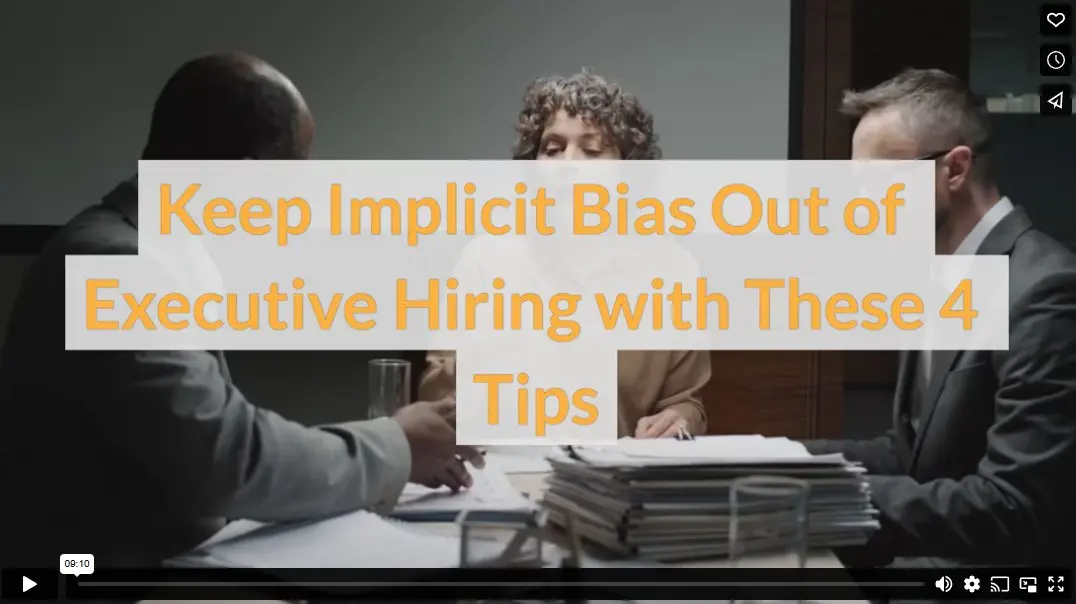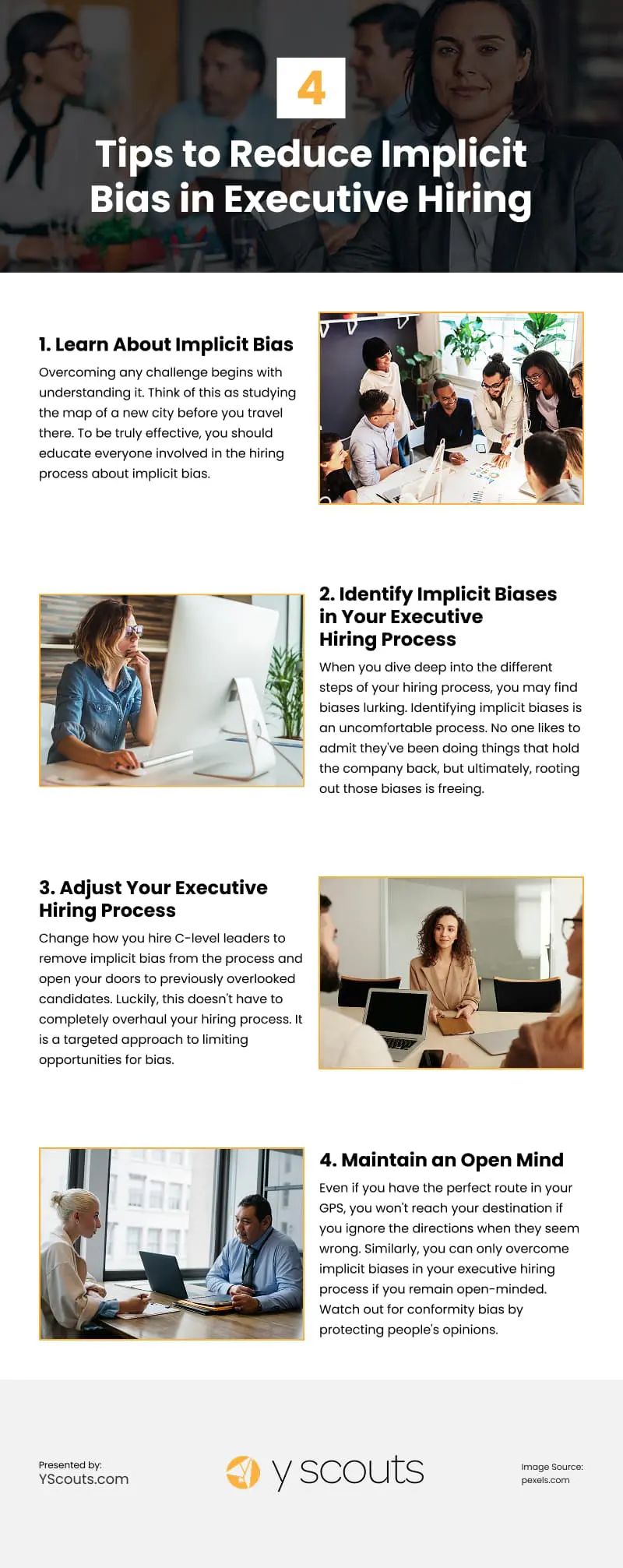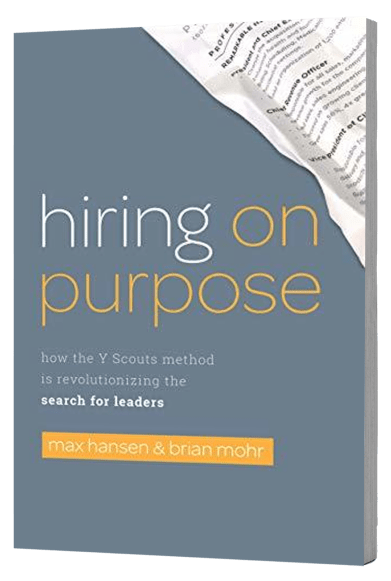Implicit or unconscious bias is like a shortcut our brains use to figure things out and make decisions quicker. But it is based on our past experiences. So, just like your favorite shortcut in Chicago would not work in Los Angeles, our implicit biases don’t always get us the outcome we want.
Hiring executives for your company is not a decision you want to get wrong. After all, the estimated cost of a new C-level hire is $1 million. That’s a costly wrong turn. Use these four actions to overcome implicit biases in your executive hiring process and get the next great leader for your team.
Table of Contents
Toggle1. Learn About Implicit Bias
Overcoming any challenge begins with understanding it. Think of this as studying the map of a new city before you travel there. To be truly effective, you should educate everyone involved in the hiring process about implicit bias.
What is Implicit Bias?
According to the American Psychological Association, implicit bias is an attitude you are unaware of toward specific social groups. It is shaped by experience and based on connections between particular qualities and social categories 1 . In the simplest terms, it is a pattern you don’t even know you have, but that you use to understand people.
For example, you talk with a family at the store and learn their two children are both 5. Your brain automatically says, “Twins”. That is an example of implicit bias. The only detail you know about these children is their age, but your experience leads you to automatically deduce more about them.
Implicit Biases in Executive Hiring
Our brain is constantly changing and adding new shortcuts throughout our lives, so the number of implicit biases we tend toward is infinite. You are probably already familiar with biases that lead to discrimination in relation to gender, race, age, and disability. Here are some implicit biases that impact executive hiring.
Affinity Bias: This bias proves that birds of a feather really do flock together. This bias favors those you can relate to when looking for a new executive. The hiring team might offer second interviews to candidates who went to the same college, supported the same football team, or listened to the same music, rather than paying attention to leadership experience.
Beauty Bias: Applicants who look the part are more likely to be hired in this bias. Your brain makes assumptions based on appearance to save time. For example, the board of directors might prefer CEO candidates with glasses since they look sophisticated and wise.
Conformity Bias: This is a peer pressure bias. A CEO with strong reservations about a candidate that the rest of the executive hiring team loves may doubt their own judgment when it doesn’t match the rest of the group’s opinions.
Status Quo: When you look for a candidate to hire who is a carbon copy of the last executive in that position, you are basing your decisions on the status quo bias. It’s the idea that hiring the same kind of person will get you the same results.
Halo Effect: This bias focuses on one positive trait to the exclusion of all else. You love the applicant with the necessary technology experience, so you ignore their limited leadership experience and grating communication style.
Horn Effect: As the opposite of the halo effect, this bias magnifies a negative quality out of proportion. The applicant may have all the experience and skills your executive team is searching for in a CFO, but the resume formatting is so sloppy that you do not consider them for a second interview.
Name Bias: When a resume comes across your desk with an odd name you have no clue how to pronounce, a name bias encourages you to reject the application. Like an affinity bias, this bias favors recognizable candidate names over exotic and unfamiliar names.
2. Identify Implicit Biases in Your Executive Hiring Process
When you dive deep into the different steps of your hiring process, you may find biases lurking.
Identifying implicit biases is an uncomfortable process. No one likes to admit they’ve been doing things that hold the company back, but ultimately, rooting out those biases is freeing.
Review your executive hiring process, recent C-level hires, and weaknesses in your current leadership team for problems caused by implicit biases. You can focus on a single bias and look for evidence, or review each area for all the mental shortcuts that currently impact your company.
At the job description stage:
- Are you writing the description as a mirror image of your former executive?
At the application stage:
- Are you getting all your applications from a single source?
At the resume review stage:
- Are you overlooking otherwise qualified people based on age, gender, educational background, etc?
At the interview stage:
- Do you over-focus on hobbies and interests that you share with the candidate?
- Are you asking all candidates the same questions to place them on a level playing field?
- Do you value feedback from all interviewers equally? Or do you welcome the perspectives of some company officials more than others?
Also, consider learning about specific hiring practices in your field to minimize bias. The technology sector, for example, has a reputation for racial biases in hiring processes. To avoid this, a tech organization could consult with retained executive recruiters for technology to find out how it can make the most educated, least biased hiring decisions.
3. Adjust Your Executive Hiring Process
Change how you hire C-level leaders to remove implicit bias from the process and open your doors to previously overlooked candidates. Luckily, this doesn’t have to completely overhaul your hiring process. It is a targeted approach to limiting opportunities for bias.
Remove names, pictures, genders, ages, races, addresses, and even colleges attended during your first review of applications. This small adjustment has a big impact. If the first look at an executive candidate is only at their qualifications, leadership experience, and skills, you remove the opportunity for many implicit biases to derail your process.
Use the same assessment for every candidate to ensure comparable evaluations. This could mean using a prewritten evaluation like the Kolbe Index or a list of success criteria that your executive hire needs to succeed. Find standard ways to compare candidates to give each an unbiased chance.
Prewrite your interview questions and ask each candidate the same questions. Standardized questions ensure that implicit biases will not derail your interview. Also, these questions will focus the conversation on what you’re really looking for in a candidate.
Pay attention to soft skills and how the candidate fits your company culture, even if their qualifications or past experience don’t line up exactly with your job description. The executive you hire needs to fit into your leadership team to be successful, but trying to sort through qualifications and personalities in the same interview may open the door to implicit biases. Use your standardized evaluations and interview questions to determine if a candidate is qualified, and separately conduct an interview to evaluate their soft skills.
4. Maintain an Open Mind
Even if you have the perfect route in your GPS, you won’t reach your destination if you ignore the directions when they seem wrong. Similarly, you can only overcome implicit biases in your executive hiring process if you remain open-minded.
Watch out for conformity bias by protecting people’s opinions. Encourage your board of directors to share their thoughts about candidates in writing or via email before discussing the results. That way, people can give their true opinions without other people’s thoughts steering them in one way or another.
Create regular opportunities to review the executive hiring process. Even when you are not actively hiring, schedule discussions with your C-level leaders and hiring team about the current hiring process and how you could improve it. Consider what skills and strengths future hires could bring to the leadership team to reach company goals and improve company growth.
Designate people in your executive hiring process to challenge biased views. Your chief human resources officer or compliance officer is an appropriate option for challenging any implicit biases they might see in the process. Your designated challenger brings up traits the hiring team might have ignored, like the halo or horns biases, and asks people to share the rationale behind their decisions.
If having a single person challenge biased views during the executive hiring process isn’t an option, schedule reflection times. Inviting your executive team to stop and examine their decision is a great way to maintain an open culture surrounding your hiring process. Use guided reflection questions or signs of biases to steer the process.
Increased Potential in Your Executive Hiring
Overcoming implicit biases in your hiring process does not remove the possibility of failure, but it does increase your potential for success. When you take action to root out these biases, you create opportunities to hire dynamic executives who will lead your company in exciting directions.
Video

Infographic
Hiring the right executive is one of the most critical decisions a company can make. It’s crucial to recognize and minimize implicit biases that can subtly influence decision-making to avoid costly mistakes. This infographic provides valuable tips for reducing implicit bias in the hiring process.
1 www.apa.org/topics/implicit-bias




